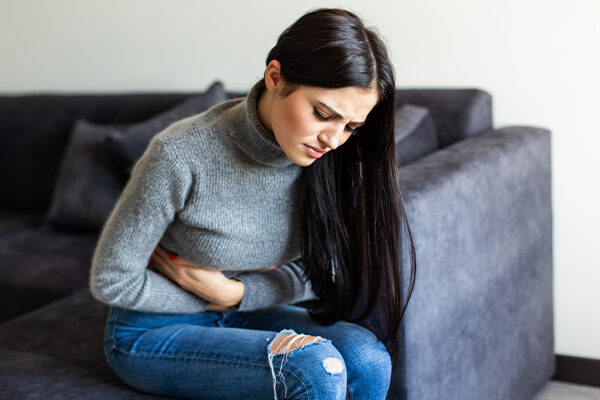Last Updated on July 25, 2024
Imagine a constant, dull ache in your lower abdomen, intensifying with every urge to use the restroom. This discomfort, unfortunately, is the reality for many suffering from Painful Bladder Syndrome (PBS). This article will explore what painful bladder syndrome is, its symptoms, and how making simple changes to your diet can help manage this condition effectively.
If you or someone you know is struggling with painful bladder syndrome, consider enrolling in Interstitial Cystitis Clinical Trials being conducted by Revive Research Institute across Michigan.
What is Painful Bladder Syndrome?
Painful bladder syndrome, also called Interstitial cystitis is a chronic condition characterized by persistent pain, pressure, or discomfort in the bladder area, specifically the suprapubic region. It leads to an increased need to urinate frequently and sudden, urgent urges to urinate, even when there’s little urine to expel.
It is estimated that approximately two-thirds of women experiencing bladder issues do not seek medical assistance, perceiving these problems as a common female condition and believing that no effective treatment is available.
Some common symptoms of painful bladder syndrome include:
- Bladder pain or discomfort
- Urgency to urinate
- Frequent urination
- Pelvic pain
- Pain during sexual intercourse
Also Read: Female Bladder Problems And Their Management
Painful Bladder Syndrome Dietary Modification: Can Diet Be The Trigger?
Research suggests that certain foods can aggravate symptoms of interstitial cystitis by altering the pH or potassium content of urine or by activating pain receptors in the bladder.
Therefore, adjusting your diet may help manage pelvic pain, urinary urgency, and frequency of urination. However, the impact of certain foods on interstitial cystitis symptoms can vary among individuals, necessitating some trial and error to determine what works best for you.
It is recommended to try an elimination diet for 1-2 weeks, which involves removing all potential trigger foods from your diet and gradually reintroducing them one at a time to identify which foods may cause symptoms.
According to the Urology Care Foundation, maintaining a food journal and reintroducing one food per day can help identify which ingredients your body can tolerate, and which may trigger bladder symptoms.
Painful Bladder Syndrome Dietary Modification: Foods to Avoid
Understanding the impact of painful bladder syndrome dietary modification is essential for those seeking relief from the often-debilitating symptoms of this condition. While there is no one-size-fits-all approach to painful bladder syndrome dietary modification, certain general guidelines can help individuals make informed choices about their food and beverage consumption.
1. Acidic Food & Beverages
The very first painful bladder syndrome dietary modification that an individual can adapt is to avoid acidic food & beverages as they can irritate the bladder lining, leading to increased discomfort and pain for individuals with painful bladder syndrome. The high acidity can cause inflammation and aggravate the symptoms.
Common trigger acidic foods & beverages include:
- Citrus Fruits and Juices: Oranges, grapefruits, lemons, and their juices are highly acidic.
- Tomatoes: Fresh tomatoes, tomato sauces, and products containing tomatoes are acidic and can aggravate the irritation in the bladder lining.
- Coffee: Both caffeinated and decaffeinated coffee contain acidic compounds.
- Alcohol: Alcoholic beverages, including wine and beer, are acidic and can dehydrate the bladder.
2. Artificial Sweeteners & Preservatives
Artificial sweeteners and preservatives can be bladder irritants, causing increased pain and urgency. These additives can aggravate PBS symptoms by triggering inflammatory responses. Examples include:
- Artificial Sweeteners: Products containing saccharin, aspartame, and other artificial sweeteners.
- Carbonated Drinks: Sodas and sparkling water can lead to bladder irritation.
- Preservatives: Foods with high levels of preservatives and additives, such as processed snacks and packaged meals.
3. Spicy Foods
Spicy foods can cause inflammation and irritation in the bladder, leading to increased discomfort and pain. Examples include:
- Hot Peppers
- Chili Powder
- Spicy Sauces
Also Read: Managing Bladder Pain: Interstitial Cystitis Foods to Avoid
Painful Bladder Syndrome Dietary Modification: Foods To Consume
Specific dietary changes can help individuals manage or avoid flare-ups of interstitial cystitis. People with interstitial cystitis can consider including the following foods in their diet:
- Fruits: Avocados, bananas, blueberries, melons, pears, apricots, dates, prunes, and raisins.
- Vegetables: Asparagus, celery, bell pepper, broccoli, beets, eggplant, peas, mushrooms, and spinach.
- Grains: Oats and rice.
- Proteins: Beef, eggs, pork, lamb, poultry, and fish.
- Nuts: Almonds, walnuts, cashews, macadamia nuts, and pistachios.
- Nut and Seed Butters: Peanut butter, almond butter, cashew butter, and sunflower seed butter.
- Dairy: Cream cheese, cheddar cheese, and low-fat or nonfat milk.
- Herbs and Spices: Basil, garlic, thyme, and rosemary.
- Beverages: Water, pear juice, blueberry juice, grain-based coffee substitutes, and chamomile or peppermint tea.
Painful Bladder Syndrome Dietary Modification: Impact of Diet
A review examining the effects of diet on interstitial cystitis revealed the following:
- Certain foods and beverages can trigger symptoms within 2–4 hours of consumption.
- Avoiding bladder-irritating foods can lead to a 50% improvement in symptoms.
- Eliminating bladder irritants from the diet and maintaining consistent water intake can significantly benefit individuals with interstitial cystitis.
Painful Bladder Syndrome Dietary Modification: Sample Meal Plan
Breakfast
- Scrambled eggs with spinach
- Oatmeal with blueberries and low-fat milk
Lunch
- Grilled chicken with brown rice and steamed asparagus
- Whole wheat wraps with turkey or chicken, avocado, and cream cheese
Afternoon Snack
- Sliced apples
- Cottage cheese
- Handful of almonds
Dinner
- Baked salmon with brown rice and steamed peas
- Grilled pork chops with sweet potato mash and steamed green beans
Also Read: A Guide to Interstitial Cystitis Self-Care
Takeaway
Painful Bladder Syndrome Dietary Modification can be a valuable tool in managing PBS. The interstitial cystitis diet involves an elimination approach to help identify foods and beverages that may aggravate your symptoms. For many, avoiding trigger foods can be a simple, effective, and non-invasive way to reduce the pain and discomfort associated with interstitial cystitis. However, it’s important to remember that dietary changes may not be effective for everyone, and additional treatment methods may be necessary for sustained symptom relief.




